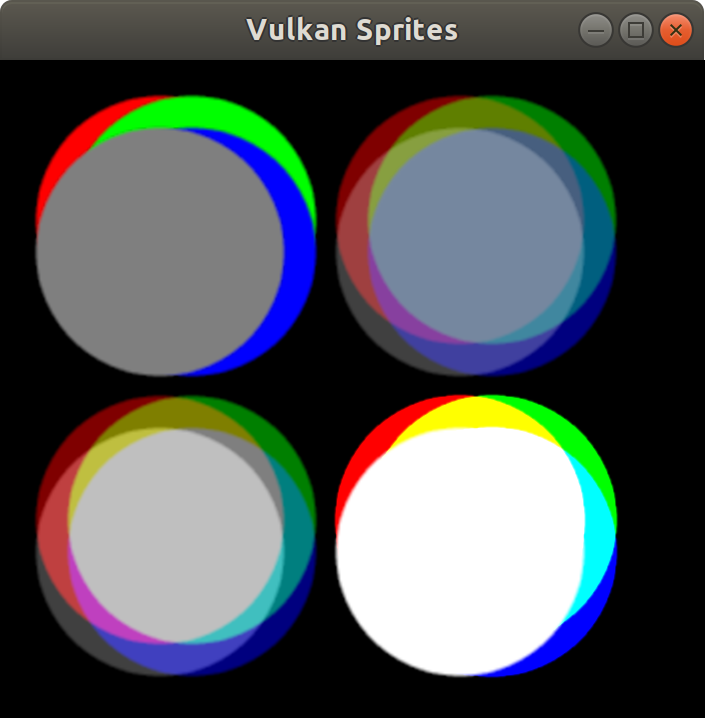Alpha blending using pre-multiplied alpha
[vulkan My sprite renderer needs to support alpha blending, and I’ve opted for a scheme using pre-multiplied alpha. I’m not going as far as pre-multiplying alpha into the textures, but rather performing the multiplication in the fragment shader. As far as the blending stage in the graphics pipeline is concerned, the alpha has been pre-multiplied, however.
Why do it like this? For my purposes, the biggest benefit is that I can represent 4 different blend modes with one blend setting in the graphics pipeline. For more detail, see Shawn Hargreaves’ blog explaining the benefits of pre-multiplied alpha.
This approach allows me to render the following image with one draw command:

Top left is no blending, top right is conventional alpha blending, bottom left is additive blending and bottom right is 2x additive blending. Each quadrant draws 4 sprites, with a white circle texture colored in 4 different colors.
The source for this is in GitHub: https://github.com/snorristurluson/vulkan-sprites
This is all rendered with the same pipeline color blend attachment state, set up with the blend op as VK_BLEND_OP_ADD, source color blend factor as VK_BLEND_FACTOR_ONE and destination color blend factor as VK_BLEND_FACTOR_ONE_MINUS_SRC_ALPHA.
VkPipelineColorBlendAttachmentState colorBlendAttachment = {};
colorBlendAttachment.colorWriteMask =
VK_COLOR_COMPONENT_R_BIT | VK_COLOR_COMPONENT_G_BIT | VK_COLOR_COMPONENT_B_BIT |
VK_COLOR_COMPONENT_A_BIT;
colorBlendAttachment.blendEnable = VK_TRUE;
colorBlendAttachment.colorBlendOp = VK_BLEND_OP_ADD;
colorBlendAttachment.srcColorBlendFactor = VK_BLEND_FACTOR_ONE;
colorBlendAttachment.dstColorBlendFactor = VK_BLEND_FACTOR_ONE_MINUS_SRC_ALPHA;
colorBlendAttachment.alphaBlendOp = VK_BLEND_OP_ADD;
colorBlendAttachment.srcAlphaBlendFactor = VK_BLEND_FACTOR_ONE;
colorBlendAttachment.dstAlphaBlendFactor = VK_BLEND_FACTOR_ZERO;
The vertex format has a field for storing the blend mode that is filled in by the DrawSprite method of the Renderer. The vertex shader uses that to adjust the vertex color before passing it on to the fragment shader, as well as setting an opacity value.
#version 450
#extension GL_ARB_separate_shader_objects : enable
const int BM_NONE = 0;
const int BM_BLEND = 1;
const int BM_ADD = 2;
const int BM_ADDX2 = 3;
layout(binding = 0) uniform UniformBufferObject {
vec2 extent;
} ubo;
layout(location = 0) in vec2 inPosition;
layout(location = 1) in vec4 inColor;
layout(location = 2) in vec2 inTexCoord;
layout(location = 3) in ivec4 inData;
layout(location = 0) out vec4 fragColor;
layout(location = 1) out vec2 fragTexCoord;
layout(location = 2) out float fragOpacity;
out gl_PerVertex {
vec4 gl_Position;
};
void main() {
int blendMode = inData[0];
float opacity = 0.0f;
vec4 color = inColor;
if(blendMode == BM_NONE) {
opacity = 1.0f;
color.a = 1.0f;
} else if(blendMode == BM_BLEND) {
opacity = color.a;
} else if(blendMode == BM_ADD) {
opacity = 0.0f;
} else if(blendMode == BM_ADDX2) {
opacity = 0.0f;
color *= 2.0f;
}
float halfWidth = ubo.extent.x / 2.0f;
float halfHeight = ubo.extent.y / 2.0f;
gl_Position = vec4(inPosition.x / halfWidth - 1.0f, inPosition.y / halfHeight - 1.0f, 0.0, 1.0);
fragColor = color;
fragTexCoord = inTexCoord;
fragOpacity = opacity;
}
The fragment shader simply multiplies the outgoing alpha value with the opacity:
#version 450
#extension GL_ARB_separate_shader_objects : enable
layout(set = 1, binding = 0) uniform sampler2D texSampler;
layout(location = 0) in vec4 fragColor;
layout(location = 1) in vec2 fragTexCoord;
layout(location = 2) in float fragOpacity;
layout(location = 0) out vec4 outColor;
void main() {
vec4 texel = texture(texSampler, fragTexCoord);
outColor.rgb = texel.rgb * fragColor.rgb * fragColor.a * texel.a;
outColor.a = texel.a * fragColor.a * fragOpacity;
}
Once the shaders are correctly set up, switching blend modes does not require changing anything in the graphics pipeline. Pretty sweet!
